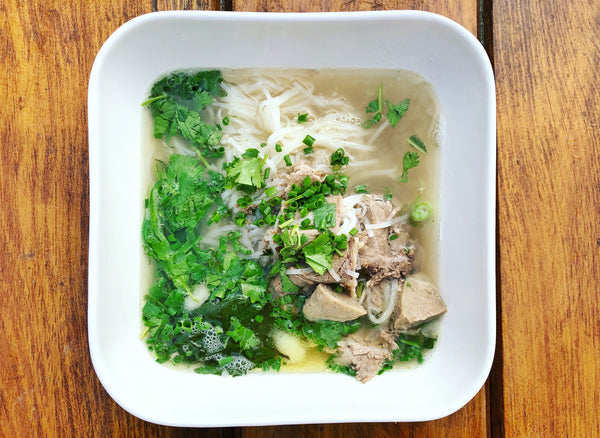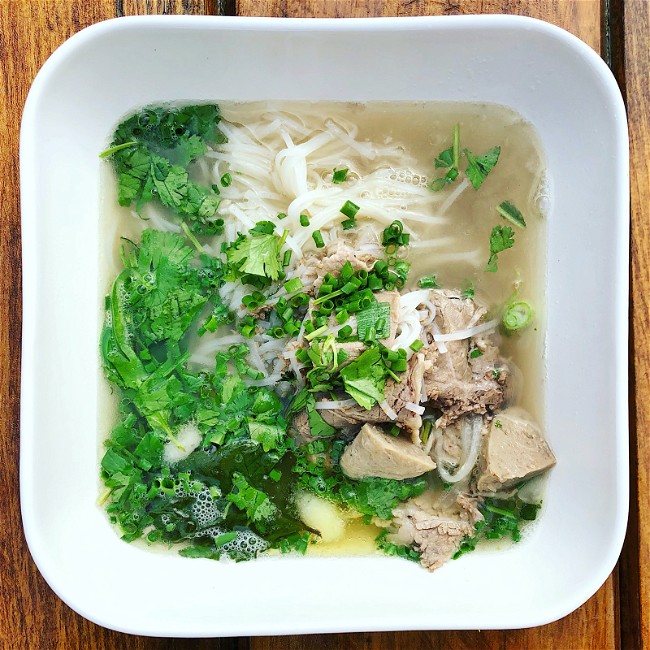
Beef Phở
Category
Soup
Servings/Yield
8
Author
Christian Leue
Considered the national dish of Vietnam, this dish has a history as rich and complex as flavor of the broth. Originating in the north, following the partition refugees brought the dish south where it exploded into countless variations. Following the Vietnam War a diaspora brought the dish around the world to major cities, creating further local variants. Chunks of Saigon cinnamon, plus red cardamom and star anise give this dish its unique flavor. It's well worth the time and effort!

Ingredients
1 (2 pound) piece of beef brisket
3 pounds of oxtail and/or beef shank
3 pounds of marrow bones
3/4 pound of shallots, washed and halved lengthwise
1/4 pound piece of ginger, halved lengthwise
-
5 whole star anise pods
-
1 Tbsp saigon bark
-
1 red cardamom pod, crushed
-
3-4 whole cloves
-
1 Tbsp fennel seed
-
1 Tbsp coriander seed
Salt
Raw sugar
The whites of 4-5 scallions, cut into 2" lenghts, reserve the greens
Flat rice noodles, rehydrated in hot water
Cooked brisket (from the broth)
Fresh Thai basil
Finely chopped scallion greens
Finely chopped cilantro leaf
Sliced jalapeño, serrano, or Thai chilis
Finely sliced sweet onion, tossed with a bit of sugar and vinegar
Fresh limes
Hoisin sauce
Tương Ớt Tỏi (garlic chili sauce)
Sriracha
Bò viên (Vietnamese meatballs*)
Nước béo (reserved fat and scallions from cooking)
Mung bean sprouts
Thinly sliced raw steak
Cooked shin or oxtail meat (from the broth)
Broth
To Serve
Optional for Serving
Directions
Make the Broth
Place the the bones in large pot, cover with water and bring to a boil. Boil hard for a few minutes, add the brisket and boil for just a minute more, then drain everything into a clean sink. Rinse the meat and bones of any coagulated proteins and rinse out your pot thoroughly with water. Return everything to pot (placing the brisket on top) and cover with fresh water, then bring to a simmer. This initial step ensures a cleaner tasting and much clearer broth.
While the meat and bones are coming to a boil prep your other ingredients. Char the onions and ginger under the broiler, on the stovetop, or on a grill. You can also use a dry skillet if you don't want to deal with open flame, but it will take a bit longer. Once blackened, aromatic, and a bit soft (6-7 minutes on a stovetop over a bare flame, longer under a broiler or in a pan), mash them gently with the back of a pan or a meat tenderizer, and then set aside.
In a dry skillet toast the spices until fragrant, then transfer to a bowl to cool. Placing them in a muslin bag will make them easier to strain out later.
Add the onion and ginger to the pot with the beef, along with 2 teaspoons of salt and 1 tablespoon of sugar. Cover the pot loosely and maintain a low simmer for one and a half to two hours, until the brisket is cooked through and tender. Remove and chill the brisket, skim any surface impurities from the broth, and add the spices.
Simmer for 2 hours, add the scallion whites, then simmer one more hour. The scallion whites can be reserved. Strain everything else from the broth, remove the meat from the oxtail and/or shin bone and reserve, and skim and reserve the fat that's on top of the broth. A fine-mesh fat skimmer makes this much easier.
Return the broth to a clean pot and bring to a simmer. Add 1/4 cup of fish sauce, then taste and adjust to your tastes with additional salt, sugar, and/or fish sauce. You want a bold broth that's noticeably salty.
Serve
Prepare a platter with sliced onion, cilantro leaf, scallion greens, Thai basil sprigs, sliced hot peppers, and fresh lime wedges.
In each bowl serve a portion of the rehydrated rice noodles (fill the bowl about halfway). Top with a good sized handful of thinly sliced cooked brisket (slice against the grain with a sharp knife), then add broth to cover.
People can garnish their soup as they prefer. Have them try the broth first before adding anything. Serve with chopsticks and a soup spoon, and small dishes in which to mix the hoisin, garlic chili sauce, and sriracha. Eat the meat by dipping it into the sauce.
My favorite variations include adding bò viên (Vietnamese meatballs with a uniquely dense and chewy texture), and serving with a side of nước béo (the spice-infused beef fat that floats to the top of the broth). You can add the fat to the soup directly, or mix it with the hot sauce to make a decadent dipping sauce for the meat.
Some other serving ideas to consider: Bean sprouts add body and texture when you're not having a lot of meat, the cooked shin/oxtail may also be to your tastes (it will have much of the gelatin cooked out and be on the drier side), and you can also poach thin slices of fresh steak in the bowl for a fresh texture and flavor.
Recipe Note
Recipe Notes
* Vietnamese meatballs are easy to buy in the frozen section of your local asian market, or online. You can also make them yourself but it takes a fair bit of work:
Mix 2 pounds of ground beef with: 2 tablespoons of fish sauce, 1 tablespoon each of sugar and potato or corn starch, 1 teaspoon each of baking powder and ground Penja white pepper.
Chill in the freezer until almost frozen, then process to a fine paste in a food processor (you may have to work in batches if your food processor is small. Chill in the freezer, then grind again until it's noticeably lighter in color and texture.
Chill once more, then using oiled hands form balls of the mixture while you heat a salted pot of water. Poach the meatballs until they cook through and float (about 7-8 minutes), then chill in ice water with a dash of vinegar added.
You can use them straight away, or freeze them (in a tightly sealed bag with air excluded) for months, and thaw and use them as needed.
Variations & Ideas
Flavor Boosts
- Add a large piece of kombu seaweed to the stock at the beginning of cooking to add another layer of savory flavor.
- Add a tablespoon of Kampot red peppercorns to your spice mixture.
• This entire dish can be done with chicken, substitute the beef with 2 chopped stewing hens (about 3 pounds each), and 8 bone-less chicken thighs. Remove the thighs when they are tender and shred the meat to serve in the soup later. The total cook time will be slightly less than with beef, about 3.5 hours total. I like to add spearmint to the garnish plate as well as some cilantro stem and/or culantro.
• The broth can be easily frozen for another meal. I will usually reduce it about 70% to save space in the freezer, freezing in ice cube trays and adding water to reconstitute. This is especially easy when you use only meatballs or fresh steak in the next soup. I'll often make a double batch in a large pot for this express purpose as it's such a useful ingredient. You can also just enjoy a cup of hot broth at any time.
• The broth and reserved fat can be used to make fun and innovative new dishes like a spin on a French dip, or phở flavored popovers, stay tuned!
Questions about this recipe? Contact us at info@laboiteny.com


